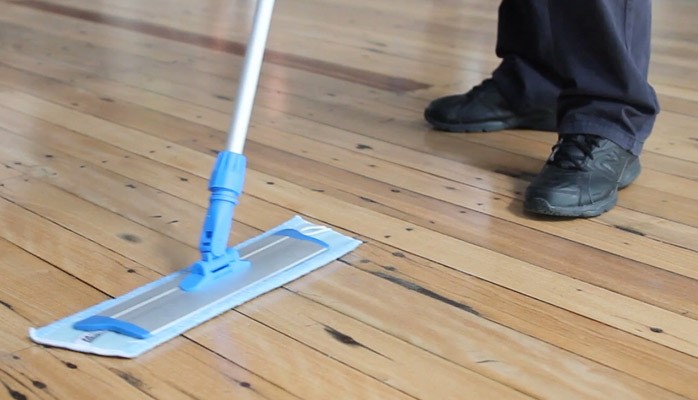
Sometimes the answer to a dirty floor is to NOT keep adding chemicals but to actually stop using them. Traditional mopping with a string mop is cumbersome and requires more effort compared with Microfibre flat mopping.
Think about the traditional mopping process – a mop and wringer bucket filled with sudsy chemicals. The cleaner needs to drag the heavy bucket around to get the job done.
After mopping with a traditional mop and bucket this is what you end up with:
- Dirty mop water in your bucket that isn’t replaced frequently enough. How often do you see a cleaner dragging a mop bucket around filled with dirty water?
- Dirty mop water spread over the floor with the dirty mop, which defeats the purpose of cleaning
- Dark grout created by the dirty water and chemicals which have soaked in and left to dry
- Tracking from chemical residue (and people wonder why their floors get dirty so quickly!)
- Traffic footprints, caused by the chemicals cleaning the underside of shoes as they walk
- Fatigue from the repetitious process of wringing the heavy mop
- A higher risk of slips, trips and falls as a result of buckets left out in open areas and slippery chemicals not being rinsed away
- Dirty water marks on walls where the wet mop hits while mopping the edges
The Microfibre flat mop has revolutionised cleaning. It can be used dry as a dust mop or wet to clean floors, right up to the edges without dirtying the walls. It’s the convenient way to mop and is perfect for spot cleaning throughout the day.
Here are some tips on using a Microfibre flat mop:
- Just add cold water (or Stabilised Aqueous Ozone) to the flat mop fringe. It’s recommended that you only use cold water as hot water opens the fibres to release dirt not capture dirt
- One fringe should clean approximately 30-40m2 before needing to be replaced with a clean one.
- The microfibre flat mop is light and pre-soaked fringes will replace the traditional mop bucket. You can even use a ‘bucket on a stick’ There are so many versions of this today.
- Carefully walk backwards and mop in a figure 8 motion to ensure the area is completely covered and you’re not walking where you have just cleaned
- Replacing the dirty fringe regularly will prevent cross-contamination as well as keep the floors and grout cleaner longer
- When the microfibre fringe is full of dirt, simply take off for laundering and replace with a clean one.
- Microfibre fringes used with Stabilised Aqueous Ozone will last longer than those used with chemicals as chemicals can damage the microfibre
- A floor cleaned with a microfibre flat mop and water/ Stabilised Aqueous Ozone will dry quicker than a floor cleaned with a chemical
Why it’s best NOT to use chemicals on a floor:
- Chemical residue will create tracking as chemicals attract dirt and dust
- Independent tests have proven that a floor cleaned with chemicals will be more slippery than a floor cleaned with Stabilised Aqueous Ozone
- Floors mopped with chemicals can leave unsightly streaks. When the bubbles dry they leave residue behind
From my experience commercial cleaners are looking for ways to save time and money. To simplify the whole cleaning process. To do this there needs to be a shift in the way we think. Sure there are great things we can learn from the past but there are some fantastic advancements in cleaning tools today that if adopted will most definitely save time and money.
If you’d like to learn more about Microfibre flat mops or Stabilised Aqueous Ozone technology, please feel free to contact me.